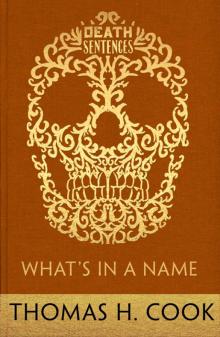- Home
- Thomas H. Cook
Instruments of Night Page 8
Instruments of Night Read online
Page 8
The article made no mention of any possibility of foul play. “It’s easy to get turned around in the woods here,” Malcolm Gerard, the local sheriff, was quoted as saying. “Even local people get lost sometimes. But they always turn up.”
But Faye Harrison did not turn up. And so on the morning of August 30, search parties were organized at Riverwood and sent out to look for her. By then the sheriff’s tone had begun to change. With regard to Faye, he told one reporter, “We have to think about other possibilities than her just being lost.”
It was not difficult for Graves to conceive of exactly what those other possibilities had been. In any such case, the police first suspected that the missing person had run away, either on her own or with someone else, in the case of Faye Harrison, most likely a boyfriend of whom the parents disapproved. Sheriff Gerard had been in office for nearly twenty years. He had no doubt encountered quite a few such “missing” persons, people who’d not actually been missing at all, at least to themselves.
But in the case of this girl, ominous considerations must have presented themselves quite soon. Runaways were usually last seen in bus and train stations, or hitchhiking on the open road. Faye Harrison, on the other hand, had last been seen walking down Mohonk Trail. And, in a fact not revealed until the following day, Jim Preston, the lone hiker who’d spotted the girl in the woods that day, had also seen a man in the same area, one he described as “standing beside a tree near the bottom of the hill.”
Who was that man?
For a time, Graves considered the question. He saw Faye as she moved along the mountain trail, dappled light falling over her blond hair, the hem of her favorite dress snagging from time to time on forest undergrowth. He tried to imagine the look in her eyes. At some point, had she heard a rustling in the trees behind her, glanced back? Had she expected to see Allison Davies trailing after her in the distance, but glimpsed someone else instead?
The following day another report appeared in the local paper: SEARCH CONTINUES FOR MISSING GIRL.
According to the report, groups of police and local residents had combed the woods west of Mohonk Ridge, the direction in which Faye appeared to have been going when last seen on Mohonk Trail. They’d fanned out along the ridge, then moved down the western slope and into the rills and hollows that spread out in all directions from the base of the mountain. Progress had been slow “due to the dense undergrowth” and the “many small caves and granite outcroppings” that dotted the area. Still, Sheriff Gerard remained hopeful that Faye would soon be found safe. “We can’t dismiss the idea that something might have happened to this girl,” the paper quoted him as saying, “but it’s too early to speculate.”
Only two hours after the sheriff’s interview, all need for speculation abruptly ended. The newspaper headline that appeared the following morning announced the sudden conclusion of the search.
BODY OF MISSING GIRL FOUND IN MANITOU CAVE
The body of Mary Faye Harrison, 16, was found yesterday evening in Manitou Cave. She was discovered by Andre Grossman, a portrait artist in summer residence at Riverwood. Mr. Grossman said that he found the girl’s body while walking near the base of Gaylord Ridge, an area just to the east of where search parties had been concentrated for most of the day. According to Mr. Grossman, Miss Harrison’s body was fully clothed. “She was curled up, with her legs drawn up, and I thought she was sleeping,” he told reporters gathered at the Davies Mansion after the discovery. Sheriff Gerard stated that an autopsy would be performed in order to determine the cause of Miss Harrison’s death. In response to reporters’ questions, the Sheriff stated that there were “indications” of foul play, but he would not speculate further, pending the results of an autopsy.
Two days later those results were reported.
Sheriff Malcolm Gerard told reporters today that Miss Mary Faye Harrison, who was reported missing the night of August 27 and was found in Manitou Cave three days later, was the victim of a homicide. According to the autopsy report, Miss Harrison died by strangulation. Further details were not released, but Sheriff Gerard stated that there was no evidence that Miss Harrison had been sexually assaulted.
For the next few hours, Graves carefully went through the newspaper coverage of everything that had happened after that—the investigation that finally led police to Jake Mosley—taking notes on each detail he thought might later generate a story.
The investigation had been conducted under the direction of Detective Lieutenant Dennis Portman of the New York State Police, and as far as Graves could tell from the subsequent newspaper reports, it had been carried out by the book.
The results of that investigation had been extensively reported in the local press. According to Homer Garrett, the local carpenter in charge of the construction of the second cottage, Mosley had entered the woods at precisely the same spot where Faye Harrison had entered them moments earlier. Mosley had not returned to the cottage for nearly three hours, and according to Garrett, the man had seemed “jumpy and agitated” upon his return.
This had been enough to focus Portman’s attention on Jake Mosley, and over the next few days the State Trooper had been able to accumulate a varied assortment of evidence against the workman. Mosley had been sighted on the same trail where Faye had previously been seen, the paper reported. In addition, under direct questioning Mosley had been unable to give any account of his whereabouts at the time of her death. He claimed he’d taken a walk in the woods, grown tired, then sat down and fallen asleep.
As evidence, all of this was pretty flimsy, as Graves knew, but within a week Detective Portman gathered considerably more incriminating information. Local residents informed him that Mosley had often mentioned the dead girl in vulgar terms, even spoken of “getting her off by herself.”
Nor was this the first time Jake Mosley had exhibited a disturbing interest in young girls. On two previous occasions he’d been found prowling a lovers’ lane, once with an ice pick protruding from his back pocket, once with a twenty-two-caliber pistol in his belt. On both occasions Mosley had been detained by police, then released with a warning that he should stay clear of such areas in the future.
But the single most telling piece of evidence had not been discovered until two weeks after Faye’s disappearance. By then a search warrant had been granted for the room Mosley occupied in a dilapidated men’s boarding-house in Britanny Falls. During the search, police found several pairs of panties in a bureau drawer. Though they had no specific markings, Mrs. Harrison identified one of the pairs as having belonged to her daughter. After initial denials, Mosley finally admitted to having stolen them from the clothesline behind the Harrison house. Yet he continued to deny having had anything to do with Faye’s murder.
After this admission, Mosley had been detained at the local jail for nearly two days, though without being formally arrested. Then, abruptly, on the morning of September 21, he had been released for “lack of evidence.”
Two days later, Portman told reporters that Mosley remained the only suspect despite the fact that no physical evidence had been found actually linking him to the murder of Faye Harrison. “We’re still looking, though,” the State Trooper assured them, “and I feel confident that something will come up.”
More than anything, as Graves discovered, Portman was looking for the rope or cord or whatever it was that had been used to strangle Faye Harrison. It had not been wound around Faye’s neck, nor discarded anywhere in the vicinity of Manitou Cave. An exhaustive search of the trail that led back to Riverwood turned up nothing. “The killer must have taken it with him,” Portman told Harold Crow in the last interview he granted on the investigation. “Or thrown it into the river. In any case, we think it’ll turn up eventually.”
But the rope had never turned up. Nor would it have mattered much if it had. At least as far as the case Portman was building against Jake Mosley was concerned. For on September 28, 1946, one week after his release, Mosley was found dead in his boardinghouse room. An autops
y report determined his death the result of “natural causes.”
CHAPTER 9
And so no one had ever been arrested, tried, or convicted for the murder of Faye Harrison. Nor had any suspect other than Jake Mosley ever emerged. In addition, no theory of the crime had ever been offered save the one held by Sheriff Gerard, that it was the result of a “botched rape,” Mosley having accosted Faye Harrison in the woods, then panicked and murdered her. He’d had both the motive and the opportunity, according to Sheriff Gerard, while no one else had had either one. “Jake Mosley killed Faye Harrison,” Gerard declared the day following Mosley’s death, “and he has been executed for it.”
But if this were so, why had Mrs. Harrison never been able to believe it?
That was the question Graves most had on his mind when he returned to his cottage later that same afternoon.
Saunders stood at the rear door of the Volvo, now dressed in his casual clothes.
“Ready to go, Mr. Graves?” he asked as Graves approached. He opened the door. “The Waves is just on the other side of Britanny Falls.”
On the way, Saunders spoke briefly of Mrs. Harrison. She’d been an old-fashioned sort of teacher, he said, a “real stickler” for grammar and punctuation. From there, he’d gone on to the history of Riverwood. The estate had taken many years to build, he said, and through it all Warren Davies had remained sternly vigilant. “He kept an eye on the details of that house like he kept one on the details of his business.”
“What was Mr. Davies’ business?” Graves asked.
“Oh, he had a finger in lots of things. Construction. Pharmaceuticals. Loads of real estate. Mines too. Gold. Silver. Diamonds. Mr. Davies had an interest in them all.”
Saunders was still cataloguing the sources of the Davies fortune ten minutes later when they reached The Waves.
The building was considerably grander than Graves expected. A large Victorian house complete with gabled roof and wide wrap-around porch, it had no doubt once been the residence of a wealthy family, inhabited by the wife and children of a prominent local banker or landowner, as Graves conceived of it, and filled with the heavy mahogany furniture common to that era, wood so dark it seemed to pull light from the air around it. Whenever he imagined a ghost, he imagined it in such a house, an airy shape gliding effortlessly among the ponderous chairs and tables, always a girl with long chestnut hair, almost human save for the eerie translucence of her body, almost alive save for the dead look in her eyes.
Now, as he moved up the cement walkway that led to the rest home, Graves wondered if Mrs. Harrison ever saw Faye as he sometimes saw Gwen, a figure moving toward him, her long hair falling loosely over her shoulders, her arms lifted pleadingly, whispering the same words, Oh, please, please, please …
She was sitting in a wooden rocker when he entered her room, facing the window, her back to him. The room was compact, with only a narrow bed, a mirrored bureau, and a chest of drawers. The walls were plain and white. There were no photographs. Instead, a large crucifix hung over the bed, and a print of the Virgin Mary on the opposite wall, so that the room resembled what Graves imagined as a nun’s cell.
“Mrs. Harrison?” Graves said softly as he walked toward the rocker, his eyes now fixed on the gentle curve of the head, a nest of white hair shining softly in the afternoon light.
“Mrs. Harrison?” he repeated.
Her head jerked up and around, a pair of light blue eyes suddenly leveling upon him.
“My name is Paul Graves,” he told her as he continued forward.
Mrs. Harrison’s gaze remained on him with an unearthly stillness. There was an unmistakable anguish in them, so that Graves instantly knew that all the passing years had done nothing to lift the vast weight of her daughter’s violent death from her shoulders.
“Allison Davies arranged for me to see you,” he said.
Mrs. Harrison did not seem pleased to receive him. She pointed to the plain metal chair to her right. “About Faye,” she said, her voice frail, little more than a whisper. She closed her eyes briefly. When they opened again, they seemed fixed in the sort of pain Graves understood too well, the agony of being unjustly bereft, of having someone taken so suddenly and cruelly, they seemed not to have been taken at all, but to linger everywhere, in everything, darkening the very quality of the air.
“I didn’t mean to drag it all up again,” she said. “I just wanted to thank Miss Davies for all her family did for us after my husband died. That’s all I said in the letter. And that I sometimes wondered about Faye.” She flinched as if she’d briefly glimpsed her daughter’s last moments in Graves’ eyes. “Some souls won’t ever have any peace. Because they’ve done something terrible.”
Graves knew that the moment had come to confront the issue at hand. Even so, he realized that he didn’t know exactly where to begin, what questions to ask. These were things Slovak would have sensed intuitively, relying on powers Graves had given him but that Graves did not himself possess. And so he decided to start with the only day in Faye’s life that he’d learned anything about. “The morning Faye disappeared,” he began. “What do you remember about it?”
Mrs. Harrison shrugged, and Graves saw her reluctance to return to that painful time. “There’s nothing much to tell. It was warm. There was a nice breeze blowing.”
As if he’d been standing beside the pond that morning, Graves saw the leaves rustle in the trees around her small home, ripple the otherwise tranquil waters of the nearby pond.
“I’d done a wash,” Mrs. Harrison added. “I was outside, pinning it to the line.”
Graves drew the notebook from his pocket, determined to take notes no less detailed than those Slovak took, then studied until dawn.
“That’s when my girl came out the back door.”
Graves envisioned Faye still sleepy as she came through the door, yawning, stretching, rubbing her eyes, her body draped in a white sleeping gown, the breeze of that long-ago morning gently riffling through her still unruly hair.
“I was surprised to see her up so early,” Mrs. Harrison said. “She didn’t work at the main house anymore.”
“Faye worked in the main house?”
“Yes,” Mrs. Harrison answered. “Aftar my husband died, Mr. Davies took a real interest in Faye.” Her eyes took on a sudden tenderness. “He noticed how Faye liked to walk in the flower garden. She was just eight years old. But she seemed curious. I guess Mr. Davies liked that. Anyway, he noticed her.”
In his mind Graves saw a little girl among the flowers, a man approaching her. Tall. Gray. The father she had lost.
“Mr. Davies kept part of the flower garden for himself, Mrs. Harrison continued. “For his studies.”
“Studies?”
“What Mr. Davies was doing. In the garden. Growing new flowers. That’s how Faye described it. Putting one flower with another one, she said. Making a different flower. She was real interested in it.” She seemed to see her daughter as she’d been at that time. A little girl with bright, inquisitive eyes. “And I guess Mr. Davies liked having her around. I don’t think Miss Allison ever took an interest in the work he did. With the flowers, I mean.” She sensed that she’d gotten off track. “Anyway, Mr. Davies asked if my Faye could work with him. He said he’d teach her what he was doing. He’d even pay her a little salary for helping him in the garden. She had a gift, he told me. For understanding things. Scientific things.” A gentle smile played on her lips. “Faye wanted to do it. She was real excited. So I brought her to Mr. Davies’ office. He gave her a piece of candy. He was a real kind man, always real thoughtful. Then they went to the garden. They worked together almost every day after that. Faye would go to his office after school. Then they’d go to the garden and work for an hour or so. She worked with Mr. Davies until she turned sixteen. Then she stopped.”
“A sudden stop?”
“Yes.”
Graves envisioned Warren Davies standing just behind a teenage girl, his eyes fixed upon the delicate sl
ope of her shoulder, the whiteness of her throat, his elegant fingers toying with the strands of her blond hair in a way that was no longer innocent. He saw Faye turn to face him, appalled by what she saw in his eyes, repulsed by his touch.
It was just a story, of course. Something he imagined. Still, Graves wondered if it might be true.
“Did Faye ever tell you why she stopped working for Mr. Davies?”
“She said he’d lost interest in the flowers,” Mrs. Harrison answered. “Just lost interest. One day he told her that he didn’t want to work in the garden anymore. So there was nothing for her to do. That was the end of it.” She was silent for a time. Then she returned to the last day of her daughter’s life. “So that’s why it seemed strange that Faye got up so early that morning. Since she wasn’t working. Had nothing to do.”
As Mrs. Harrison went on to describe her final conversation with her daughter, Graves found that he could hear their voices sounding in his head.
You look tired.
I couldn’t sleep.
How come?
I don’t know.
Graves felt he was watching the scene from a scant few yards away, a silent observer, scribbling notes, as mother and daughter hung the morning wash, talking companionably as they did so.
Got any plans this morning, honey?
No.
Well, there’s going to be a party when Mrs. Davies’ portrait is finished. You might want to go down to Britanny Falls and get yourself a new dress.
I have my blue dress. I don’t need a new one.
Well, you can be sure that Mona will have a new one.
“Mona?” Graves asked.
“Mona Flagg,” Mrs. Harrison replied. “Edward Davies’ girlfriend.”
Graves wrote the name in his notebook.
“Mona lived at Riverwood that summer,” Mrs. Harrison said. “Pretty girl. Her whole life ahead of her.” She stopped. Graves knew that she was comparing the open future of Mona Flagg with the tragically shortened one of her daughter. “Those two were together all the time. Edward and Mona.”

 The Interrogation
The Interrogation Sacrificial Ground
Sacrificial Ground The Fate of Katherine Carr
The Fate of Katherine Carr What's In A Name
What's In A Name Blood Innocents
Blood Innocents Peril
Peril A Dancer In the Dust
A Dancer In the Dust Breakheart Hill
Breakheart Hill The Chatham School Affair
The Chatham School Affair The City When It Rains
The City When It Rains Blood Echoes
Blood Echoes Mortal Memory
Mortal Memory Evidence of Blood
Evidence of Blood Into the Web
Into the Web The Crime of Julian Wells
The Crime of Julian Wells Blood Echoes: The Infamous Alday Mass Murder and Its Aftermath
Blood Echoes: The Infamous Alday Mass Murder and Its Aftermath Night Secrets
Night Secrets Places in the Dark
Places in the Dark The Orchids
The Orchids Elena
Elena Streets of Fire
Streets of Fire Instruments of Night
Instruments of Night Sacrificial Ground fc-1
Sacrificial Ground fc-1 The Quest for Anna Klein
The Quest for Anna Klein Sandrine's Case
Sandrine's Case Quest for Anna Klein, The
Quest for Anna Klein, The Fatherhood
Fatherhood Flesh and Blood
Flesh and Blood Red Leaves
Red Leaves